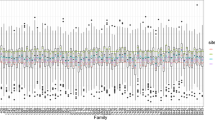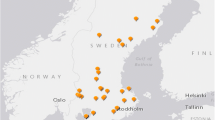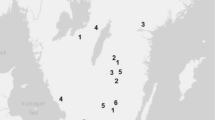Abstract
Sitka spruce (Picea sitchensis (Bong.) Carr.), is a highly valuable commercial tree species in Ireland, UK and elsewhere in Europe but there is relatively little information available in relation to the performance of improved material. The primary objective of this study was to explore the genetic variation in competitive ability and determine how a spatial model improved the accuracy of genetic estimates over time for Sitka spruce. To achieve this, the study employed competition index (Hegyi’s I) and spatial analysis on height and diameter data from genetic improvement trials in Ireland. A total of 54 half-sib families of Sitka spruce were included in the study. The trials had been established to identify superior genotypes among the plus trees which had been included in the improvement programme in Ireland. The study revealed that spatial heterogeneity significantly affects the genetic estimates for Sitka spruce. The results indicated that spatial analysis could provide valuable insights into the genetic trials of Sitka spruce and improve the accuracy of genetic evaluations. Heritability increased by 104% for diameter at breast height (DBH) using a spatial analysis approach, compared with a more traditional non-spatial model approach. It was found that thinning practices can affect the response of genetic performance to spatial heterogeneity. In addition, genetic variation in competitive ability was observed. The results highlight the importance of considering spatial dependence in the design but more importantly in the analysis of genetic trials and provides a framework for future research on the genetic improvement of Sitka spruce populations.




Similar content being viewed by others
References
Anning AK, McCarthy BC (2013) Competition, size and age affect tree growth response to fuel reduction treatments in mixed-oak forests of Ohio. For Ecol Manag 307:74–83
Anselin L (1995) Local indicators of spatial association—LISA. Geogr Anal 27:93–115
Anselin L, Bera AK (1998) Spatial dependence in linear regression models with an introduction to spatial econometrics. Statist Textbooks Monogr 155:237–290
Bartlett M (1978) Nearest neighbour models in the analysis of field experiments. J Roy Stat Soc Ser B (Methodol) 40:147–158
Bian L, Zheng R, Su S, Lin H, Xiao H, Wu HX, Shi J (2017) Spatial analysis increases efficiency of progeny testing of Chinese fir. J For Res 28:445–452
Binkley D, Stape JL, Bauerle WL, Ryan MG (2010) Explaining growth of individual trees: light interception and efficiency of light use by eucalyptus at four sites in Brazil. For Ecol Manag 259:1704–1713
Brotherstone S, White I, Sykes R, Thompson R, Connolly T, Lee S, Woolliams J (2011) Competition effects in a young Sitka spruce (Bong. Carr) clonal trial. Silvae Genetica 60:149–155
Cannell MR, Sheppard L, Ford E, Wilson RF (1983) Clonal differences in dry matter distribution, wood specific gravity and foliage «efficiency» in Picea sitchensis and Pinus contorta. Silvae Genetica 32:195–202
Cappa EP, Muñoz F, Sanchez L (2019) Performance of alternative spatial models in empirical Douglas-fir and simulated datasets. Annals of Forest Science 76:1–16
Chen Z, Helmersson A, Westin J, Karlsson B, Wu HX (2018) Efficiency of using spatial analysis for Norway spruce progeny tests in Sweden. Ann for Sci 75:1–13
Cope OL, Lindroth RL, Helm A, Keefover-Ring K, Kruger EL (2021) Trait plasticity and trade-offs shape intra-specific variation in competitive response in a foundation tree species. New Phytol 230:710–719
Costa e Silva J, Potts BM, Gilmour AR, Kerr RJ (2017) Genetic-based interactions among tree neighbors: identification of the most influential neighbors, and estimation of correlations among direct and indirect genetic effects for leaf disease and growth in Eucalyptus globulus. Heredity 119(3):125–135
Costae Silva J, Kerr RJ (2013) Accounting for competition in genetic analysis, with particular emphasis on forest genetic trials. Tree Genet Genomes 9:1–17
Costae Silva J, Dutkowski GW, Gilmour AR (2001) Analysis of early tree height in forest genetic trials is enhanced by including a spatially correlated residual. Canad J For Res 31:1887–1893
Cullis B, Gleeson A (1991) Spatial analysis of field experiments-an extension to two dimensions. Biometrics 101:1449–1460
DAFM (2021) Department of agriculture food and the marine (DAFM), Ireland. Forest Statistics Ireland 2021. https://www.teagasc.ie/media/website/crops/forestry/advice/Forest-Statistics-Ireland-2021.pdf
Donald Ct (1968) The breeding of crop ideotypes. Euphytica 17:385–403
Donald C, Hamblin J (1976) The biological yield and harvest index of cereals as agronomic and plant breeding criteria. Adv Agron 28:361–405
Dong L, Xie Y, Wu HX, Sun X (2020) Spatial and competition models increase the progeny testing efficiency of Japanese larch. Can J for Res 50:1373–1382
Donnelly L, Jagodziński AM, Grant OM, O’Reilly C (2016) Above-and below-ground biomass partitioning and fine root morphology in juvenile Sitka spruce clones in monoclonal and polyclonal mixtures. For Ecol Manage 373:17–25
Dutkowski GW, Silva JCE, Gilmour AR, Lopez GA (2002) Spatial analysis methods for forest genetic trials. Canad J For Res 32:2201–2214
Dutkowski GW, Costa e Silva J, Gilmour AR, Wellendorf H, Aguiar A (2006) Spatial analysis enhances modelling of a wide variety of traits in forest genetic trials. Canad J For Res 36:1851–1870
Ericsson T (1997) Enhanced heritabilities and best linear unbiased predictors through appropriate blocking of progeny trials. Can J for Res 27:2097–2101
Fasoula DA, Fasoula VA (1997) Gene action and plant breeding. Plant Breed Rev 15:315–374
Fisher RA, Yates F (1963) Statistical tables for biological, agricultural and medical research, edited by ra fisher and f. yates. Oliver and Boyd, Edinburgh
Forestry Commission (2019) Forest research, Edinburgh, United Kingdom. Forestry Statistics 2019. https://www.forestresearch.gov.uk/tools-and-resources/statistics/forestry-statistics/forestry-statistics-2019/
Fox JC, Ades PK, Bi H (2001) Stochastic structure and individual-tree growth models. For Ecol Manag 154:261–276
Fox JC, Bi H, Ades PK (2007) Spatial dependence and individual-tree growth models: I. Characterising spatial dependence. For Ecol Manage 245:10–19
Gilmour AR, Cullis BR, Verbyla AP (1997) Accounting for natural and extraneous variation in the analysis of field experiments. J Agric Biol Environ Stat 10:269–293
Hamann A, Namkoong G, Koshy M (2002) Improving precision of breeding values by removing spatially autocorrelated variation in forestry field experiments
Höwler K, Annighöfer P, Ammer C, Seidel D (2017) Competition improves quality-related external stem characteristics of Fagus sylvatica. Can J for Res 47:1603–1613
Höwler K, Vor T, Seidel D, Annighöfer P, Ammer C (2019) Analyzing effects of intra-and interspecific competition on timber quality attributes of Fagus sylvatica L.–from quality assessments on standing trees to sawn boards. Eur J Forest Res 138:327–343
Ivkovich M, Dutkowski GW, McRae TA, Buxton PA, Sasse J, Elms S (2023) Scaling of estimated breeding values for stand productivity in the Australian Pinus radiata breeding program. Aust for 86(1):39–51
Kim TJ, Bullock BP, Stape JL (2015) Effects of silvicultural treatments on temporal variations of spatial autocorrelation in Eucalyptus plantations in Brazil. For Ecol Manag 358:90–97
Lee SJ, Connolly T (2010) Finalizing the selection of parents for the Sitka spruce (Picea sitchensis (Bong.) Carr) breeding population in Britain using mixed model analysis. For Int J For Res 83:423–431. https://doi.org/10.1093/forestry/cpq024
Magnussen S (1994) A method to adjust simultaneously for spatial microsite and competition effects. Can J for Res 24:985–995
Moran PA (1950) Notes on continuous stochastic phenomena. Biometrika 37:17–23
Muir WM (2005) Incorporation of competitive effects in forest tree or animal breeding programs. Genetics 170:1247–1259
Muñoz, F, Sanchez, L (2017) BreedR: statistical methods for forest genetic resources analysts. https://github.com/famuvie/breedR. Accessed January 2023
Newton M, Cole L (2012) Sitka spruce and western hemlock stand and tree growth 10 years after precommercial thinning in southeast Alaska. West J Appl for 27:5–11. https://doi.org/10.1093/wjaf/27.1.5
Patterson HD, Thompson R (1971) Recovery of inter-block information when block sizes are unequal. Biometrika 58:545–554
Peterson EB, Peterson NM, Weetman GF, Martin PJ (1997) Ecology and management of Sitka spruce: emphasizing its natural range in British Columbia. UBC Press, Vancouver
Pont D, Dungey HS, Suontama M, Stovold GT (2021) Spatial models with inter-tree competition from airborne laser scanning improve estimates of genetic variance. Front Plant Sci 11:596315
R Core Team (2020) R foundation for statistical computing, Vienna, Austria. R: a language and environment for statistical computing. https://www.R-project.org/
Resende RT, Marcatti GE, Pinto DS, Takahashi EK, Cruz CD, Resende MDV (2016) Intra-genotypic competition of eucalyptus clones generated by environmental heterogeneity can optimize productivity in forest stands. For Ecol Manage 380:50–58
Rey SJ, Anselin L (2009) PySAL: a python library of spatial analytical methods. Handbook of applied spatial analysis: software tools, methods and applications. Springer: London. pp 175–193
Samra J, Gill H (1993) Modeling of variation in a sodium-contaminated soil and associated tree growth. Soil Sci 155:148
Schoonderwoerd H, Mohren G (1988) Autocorrelation and competition in even-aged stands of douglas-fir in the Netherlands. USDA forest service general technical report NC-north central forest experiment station (USA)
Shi H, Zhang L (2003) Local analysis of tree competition and growth. Forest Sci 49(6):938–955
Singh DP, Singh AK, Singh A (2021) Plant breeding and cultivar development. Academic Press
Wright A (1977) Predictions of non-linear responses to selection for forage yield under competition. Theor Appl Genet 49:201–207
Acknowledgements
Mr Dermot O’Leary the Nurseries Production Business Manager at Coillte provided permission to access the trial sites and original datasets. The authors acknowledge gratefully the assistance of Mr Donal O’Hare, Mr Ciaran Foran and Ronan Cashell in carrying out inventory and field data collection. Also Dr Alistair Pfeiffer who provided information about original establishment and research objectives concerning the field trials.
Funding
The research leading to these results received funding from the Irish Department of Agriculture, Food and the Marine (Genesis Project, 17/C/297).
Author information
Authors and Affiliations
Contributions
SY collected data in 2019, analysed the data and wrote the original manuscript. BT and CO supervised each stage of the study, reviewed and edited the original manuscript. SB and PÁ-Á reviewed and edited the text and contributed to the methodological approaches used. NF organized the historical data. The authors greatly appreciate the anonymous reviewers’ insightful comments and suggestions that improved the quality of this paper.
Corresponding author
Ethics declarations
Conflict of interest
The authors declare that they have no known competing financial interests or personal relationships that could have influenced the work reported in this paper.
Additional information
Publisher's Note
Springer Nature remains neutral with regard to jurisdictional claims in published maps and institutional affiliations.
Appendix 1
Appendix 1
See Tables 5, 6 and 7, Figs. 5, 6, 7 and 8.
Local indicator of spatial dependence (LISA) cluster and outlier map based on analysis of local Moran’s I for a) DBH at age 15, b) DBH at age 20 and c) DBH at age 24 along the row and columns of the layout map of the experiment (solid lines in the figures indicate the boundaries of blocks) at Site 1
Local indicator of spatial dependence (LISA) cluster and outlier map based on analysis of local Moran’s I for a) height (HT) at age 11, b) diameter at breast height (DBH) at age 11, c) HT at age 32, d) DBH at age 32 and e) Pilodyn penetration depth (PP) at age 13 at Site 2 along the row and columns of the layout map of the experiment (solid lines in the figures indicate the boundaries of blocks) of the layout map of the experiment. Note: regarding subject-neighbouring trees, HH: high-high cluster; LL: low-low cluster; HL: high-low outlier; LH: low–high outlier; NS: non-significant
Rights and permissions
Springer Nature or its licensor (e.g. a society or other partner) holds exclusive rights to this article under a publishing agreement with the author(s) or other rightsholder(s); author self-archiving of the accepted manuscript version of this article is solely governed by the terms of such publishing agreement and applicable law.
About this article
Cite this article
Yang, S., Tobin, B., Byrne, S. et al. Improving the efficiency of genetic selection in Sitka spruce using spatial and competition factors. New Forests (2023). https://doi.org/10.1007/s11056-023-10019-5
Received:
Accepted:
Published:
DOI: https://doi.org/10.1007/s11056-023-10019-5








